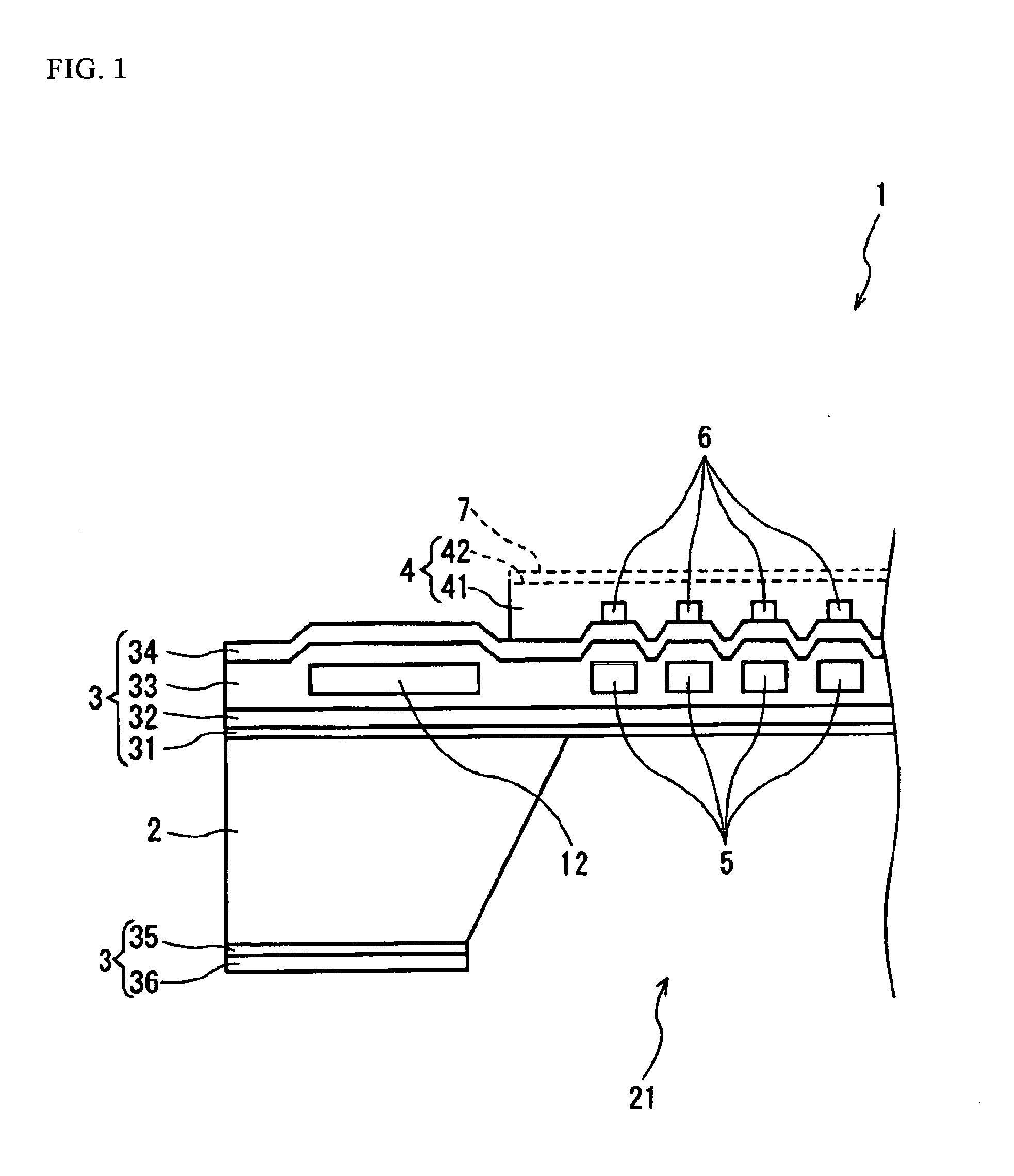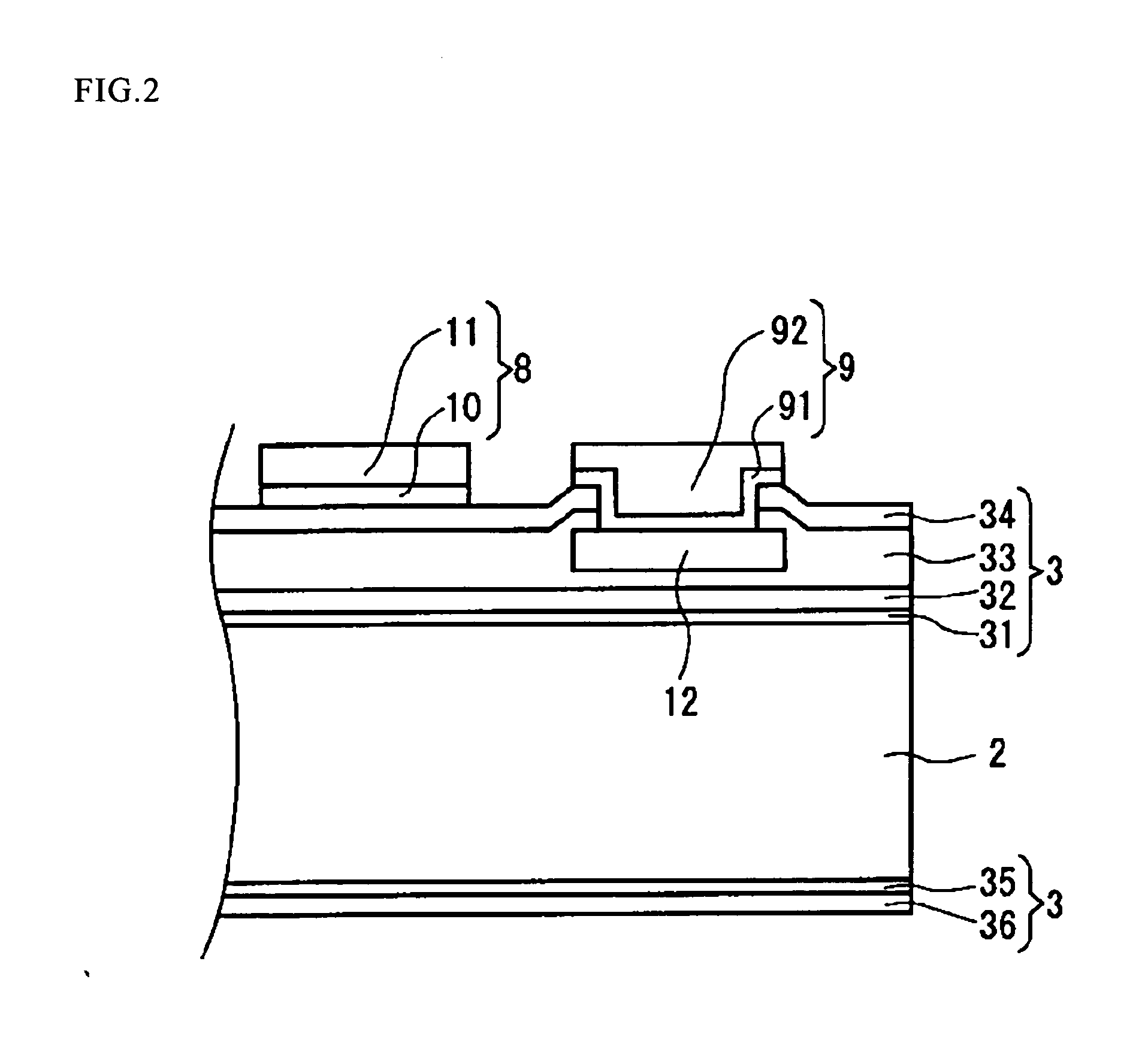[0012] In a first aspect of the present invention, a catalytic portion (catalyst substance) is dispersedly formed on a surface of a metal-oxide semiconductor portion, and an insulating portion is dispersedly formed on the surface of the metal-oxide semiconductor portion where the catalytic portion is formed (i.e. on a gas sensing portion). The first surface additive rate, which is expressed by Si / (M+Si), of the metal-oxide semiconductor portion is determined to be 65% or more to 97% or less, and the second surface additive rate, which is expressed by Si / (Sn+Si), of the same is determined to be 75% or more to 97% or less. That is, the metal-oxide semiconductor portion and the catalytic portion which constitute the gas sensing portion are exposed to the surface of the insulating portion so that the
negative charge of the
oxygen (O2−) in the atmosphere may be adsorbed on to the surface of the metal-oxide semiconductor portion, thereby functioning as a gas sensor. Furthermore, SiO2 constituting the insulating portion has a characteristic which traps hydroxyl group OH−, preventing OH− from being adsorbed on to an O2−adsorption site of the metal-oxide semiconductor portion in a high temperature and
high humidity atmosphere. The gas sensor of the present invention may demonstrate excellent detection accuracy and humidity resistance because the catalytic portion and the insulating portion are formed on the surface of the metal-oxide semiconductor portion so that the surface additive rate thereof may be within the above-mentioned ranges.
[0013] When the first surface additive rate expressed by Si / (M+Si) of the metal-oxide semiconductor portion is less than 65%, or when the second surface additive rate expressed by Si / (Sn+Si) of the same is less than 75%, a proportion where the metal-oxide semiconductor portion and the catalytic portion are exposed in between the insulating portions will be large. As a result, the proportion of the insulating portion will be relatively small, causing hydroxyl group OH31 to be unlikely to be trapped in a high temperature and
high humidity atmosphere whereby the sensitivity of the gas sensor (proportion of resistance value in the metal-oxide semiconductor portion when a gas to be detected is present vs. absent) will deteriorate. On the other hand, when the first surface additive rate expressed by Si / (M+Si) of the metal-oxide semiconductor portion is larger than 97%, or when the second surface additive rate expressed by Si / (Sn+Si) of the same is larger than 97%, a proportion where the metal-oxide semiconductor portion and the catalytic portion are exposed in between the insulating portions will be small. That is, since the O2− adsorption site of the gas sensor lessens, irrespective of the existence of the gas to be detected, the resistance of the metal-oxide semiconductor portion will hardly change (i.e. remain at a large value), resulting in a deterioration of the sensitivity of the gas sensor.
[0014] Moreover, since the insulating portion is comprised mainly of SiO2, it may be inexpensively manufactured, as well as reducing environmental load.
[0015] In addition, in the present invention, the surface additive rate is obtained from the number of atoms measured by an X-
ray photoelectron
spectroscopy (XPS). In detail, a photoelectron
peak area of an element subjected to a measurement among the elements existing on the metal-oxide semiconductor portion is measured by an X-
ray surface analyzer (e.g., Quantera SXM, manufactured by Physical
Electronics) on the condition that a detection depth is 4-5 nm (45 degrees of extraction angles) in the detection area of 100 μm, using an A1K α
ray (1486 keV). Then, the number of atoms of each element, which is subjected to the measurement, is determined quantitatively (relative determinate quantity) by the equation shown in (1). The above-mentioned surface additive rate is calculated according to the number of atoms of thus-determined quantity of each element. Ci={(Ai / RSFi) / (ΣiAi / RSFi)}×100 . . . (1)
[0016] wherein, Ci shall represent a determined quantity value (atomic%) of the element i subjected to the measurement, Ai shall represent a photoelectron
peak area of the element i subjected to the measurement, and RSFi shall represent a relative
sensitivity coefficient of the element i subjected to the measurement.
[0017] Moreover, in the present invention, “Main component” denotes a component that occupies 80% by weight or more, preferably 90% by weight or more, further preferably 95% by weight or more of the total components contained.
 Login to View More
Login to View More 


